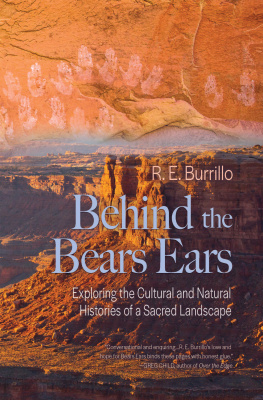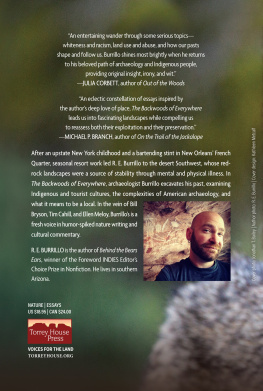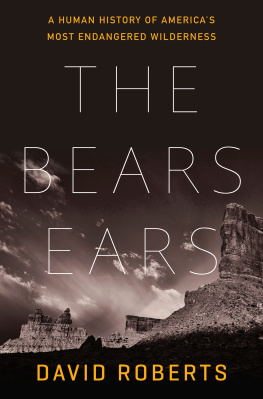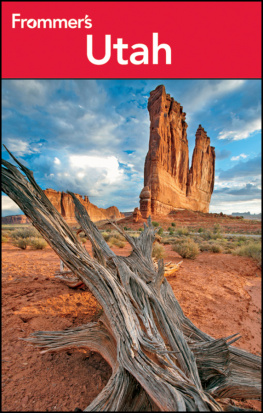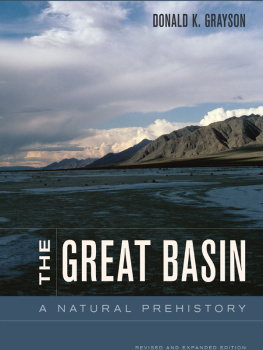Contents
Page List
Guide
Praise forBehind the Bears Ears
R. E. Burrillo is an archaeologist who writes nothing like an archaeologistnot stuffy and technical but conversational and enquiring. His deeply personal book traces the thirteen-thousand-year arc of human occupation of the wondrous, contentious place we call Bears Ears. Drawing from his explorations and fieldwork of the regions plateaus and canyons, where past and present coexist, Burrillos love and hope for Bears Ears binds these pages with honest glue.
GREG CHILD, author of Over the Edge
The desert archaeology of R. E. Burillo is alchemical. He conjures empathy for ethnography, transforms soil strata into living stories. Its the trick of poets and magicians, the way the man vanishes colonialist, arms-length fetishizing and categorizing of ancient artifacts. Fierce yet playful, admonishing and ambitious, Behind the Bears Ears is as vast and consuming as the landscape itself, a read in which white America learns what it has failed to grasp by both excavation and exploration. Come to it now, on bended knees with eyes wide open to this nations erasure of all things Indigenous.
AMY IRVINE, author of Air Mail and Desert Cabal
An engagingly personal, well-informed, wide-ranging account of Bears Ears and its archaeology, its ongoing importance to Native peoples, and its future.
STEPHEN H. LEKSON, author of A Study of Southwestern Archaeology
Behind the Bears Ears conveys a deep respect for the place and the people who have lived closest to it. A fine primer for newcomers to the region and an entertaining refresher course for those already embedded in the landscape.
SCOTT THYBONY, author of The Disappearances
BEHIND THE BEARS EARS
BEHIND THE BEARS EARS
EXPLORING THE CULTURAL AND NATURAL HISTORIES OF A SACRED LANDSCAPE
by R. E. Burrillo
TORREY HOUSE PRESS

Salt Lake City Torrey

First Torrey House Press Edition, October 2020
Copyright 2020 by R. E. Burrillo
All rights reserved. No part of this book may be reproduced or retransmitted in any form or by any means without the written consent of the publisher.
Published by Torrey House Press
Salt Lake City, Utah
www.torreyhouse.org
International Standard Book Number: 978-1-948814-30-0
E-book ISBN: 978-1-948814-31-7
Library of Congress Control Number: 2019955067
Cover art by Jonathan Bailey
Cover design by Kathleen Metcalf
Interior design by Rachel Buck-Cockayne
Distributed to the trade by Consortium Book Sales and Distribution
Torrey House Press offices in Salt Lake City sit on the homelands of Ute, Goshute, Shoshone, and Paiute nations. Offices in Torrey are in homelands of Paiute, Ute, and Navajo nations.
Acknowledgments
The author thanks Dr. Bill Lipe, for carefully reviewing the entire manuscript and offering tons of invaluable edits; Drs. Steve Lekson and Marc Toso, for also reviewing the entire manuscript and offering their own suggestions and impressions; and Donna Rex Baker for additional edits and suggestions. Lyle Balenquah, Eric Descheenie, Alastair Bitsi, Ajani Yepa, Honor Keeler, and Angelo Baca provided an immensity of Indigenous perspectives, insights, quotes, and media sensitivity training. Thanks are also due to Tim Peterson and Dr. John Ruple for providing information and guidance about the recent history of the conservation struggle; Rosemary Sucec, for her ethnographic input and review; Dr. Kevin Jones, for his help with the book and for everything else that he does; and Dr. Thomas King, for providing useful guidance and edits vis--vis the cultural resource regulations and practices referenced throughout the book. Jonathan Bailey provided the cover, and was especially helpful in crafting Chapter One. David Roberts and Morgan Sjogren were immensely helpful in crafting Chapters Eleven and Twelve. Thanks also to Aaron, Connie, Greg, Ben, Josh, Amanda and Zak, and Eran for enough shared adventure and wisdom to keep me thoroughly lost for centuries; and to Molly, Chelsea, Shayne, Ryno, Mark and Virginia, Emily, Sasha, and one or two other Flagstaff freaks for keeping the home fires burning.
Timeline (Pecos Sequence)
PERIOD YEARS BEFORE PRESENT (BP) OR BC/AD | GENERAL DIAGNOSTIC FEATURES AND ARTIFACTS |
Paleoindian
> 13,000-10,000 BP | Exact timing and method of arrival still hotly debated. Small groups of people foraged over very large territories, large (now extinct) mammals were hunted. Clovis is the oldest identifiable formal material culture, followed by Folsom. |
Archaic
10,000-2,000 BP | Subsistence lifestyle based on wild foods. High mobility, especially during the middle portion, with generally low population density. Diet breadth increased over time. |
Basketmaker II
1500 BC-AD 500 | Includes what some researchers call the Early Agricultural period (2000500 BC), semi-sedentary habitation in shallow pit houses, no pottery, maize and squash. Cedar Mesa appears to have been the focal point of settlement in southeast Utah during this period. |
Basketmaker III
AD 500-750 | Habitation in deeper pit houses and first appearance of communal architecture. Beans are added to farming. Appearance of bow-and-arrow and first formal pottery. Turkeys are raised for companionship and to make feather blankets. |
Pueblo I
AD 750-900 | Large villages and kivas appear, deep pit houses still in use, red ware ceramics produced in Bears Ears become incredibly popular throughout the region. Settlements shift toward high uplands and the Bluff area, with most of Cedar Mesa depopulated. |
Pueblo II
AD 900-1150 | Most of southeast Utah depopulated, followed by rapid growth and expansion of vast social system centered on Chaco Canyon. Great houses and Chacoan roads appear throughout the region. Corrugated and elaborate black-on-white (cont.) ceramics proliferate, while red ware production in Bears Ears comes to a halt. |
Pueblo III
AD 1150-1300 | Post-Chaco diaspora, large pueblos and towers appear near canyon heads and water sources, and people begin living in cliff dwellings. Turkeys are still raised, but now theyve become a food item. Curious influx of people from Kayenta region. |
Pueblo IV
AD 1300-1500 | Colorado Plateau depopulated by Ancestral Pueblo groups by about AD 1290, with most people moving into large plaza-oriented pueblos in the Rio Grande region and the Hopi mesas. Although full-time occupation had halted, archaeology and oral histories both suggest that Pueblo people never stopped visiting and utilizing southeast Utah. Earliest Ute, Paiute, and Din archaeology dates to this general time period or a little after. |
Protohistoric
AD 1500-1850 | |

